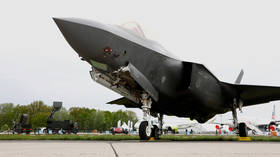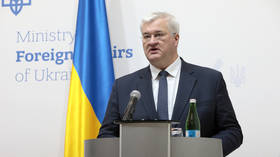Lockheed Martin declares Mission (almost) Accomplished, brings F-35’s 100+ safety flaws down to 8... and hundreds of lesser issues

The maker of the troubled F-35 fighter jet claims to have solved “most” of the safety issues that plagued the $1.5 trillion plane – but flaws that could injure pilots are still present, on top of hundreds of software issues.
Lockheed Martin has fixed all but eight of the 111 ‘Category 1’ flight safety issues found during a January 2018 analysis of the fighter jet program, Bloomberg reported on Monday, citing the Government Accountability Office analyst in charge of monitoring the pricey plane’s development. Category 1 issues are those that can “injure or kill pilots or otherwise jeopardize the plane’s security.”
Also on rt.com Mission incapable? Pentagon review finds gun on F-35 fighter jet can’t hit targets & 800+ software glitches – reportAnd what of the remaining eight? The Pentagon and Lockheed have “procedures in place to work around” those issues, analyst Jon Ludwigson told the outlet, striking an optimistic tone. The problems include an issue with cabin air pressure that could injure pilots’ ears, as well as flaws in the plane’s night-vision camera and sea-searching radar – but Ludwigson nevertheless praised the fighter jet program for working with the military “to really prioritize what needs to get fixed versus what would be just a helpful thing to the pilot.”
The Pentagon has had years to fix many of the problems, which it has classed as Category 1B, or “critical impact on mission readiness.” The Defense Department’s F-35 office told Bloomberg three of the remaining flaws were present during the “intensive combat testing” phase that began in late 2018, while five others came out during software testing. Five of the issues are supposed to be resolved by December, the office said, though the radar problem won’t have a fix until 2024.
Those are just the big issues, however – Lockheed Martin admitted the F-35 is also dealing with some 860 “software and hardware deficiencies,” though the company claimed 104 of those have been fixed pending verification and the others are being addressed. A few have been written off as “‘mission enhancements’ that don’t need immediate attention.”
Most – 85 percent – are said to be software-related, though a software glitch can still drive a plane into the ground. “When you are flying close to the speed of sound… seemingly minor issues like a glitched computer can mean the difference between success and failure,” Project on Government Oversight analyst Dan Grazier told Bloomberg.
Also on rt.com Why is it even called 5th generation? Pentagon's decision not to fix supersonic speed issue with F-35C defeats jet's very purposeOther problems have been revised as non-issues, like the failure of the F-35C model to fly at supersonic speeds for prolonged periods due to tail damage. That flaw was deemed “not worth fixing” because it would require prohibitive amounts of money to be dumped into the already frighteningly over-budget project. An assessment earlier this year found the Air Force model of the plane’s autocannon was basically useless, incapable of hitting a target due to defective mounting.
The F-35 has blown numerous production deadlines through nearly two decades in development. The Pentagon is expected to decide by early 2021 if it will greenlight full production of the planes, though some 520 glitch-ridden jets have already been delivered out of a planned 3,200 to the US and its allies. In 2019, just a quarter of F-35s in service were found to be mission-capable, largely due to a dearth of spare parts. The seemingly endless string of problems plaguing the plane have led some lawmakers to question whether shoveling more money into the $1.5 trillion-plus program is a good idea.
Think your friends would be interested? Share this story!














